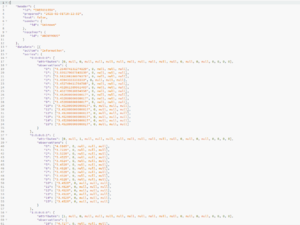Difference between revisions of "Fusion-JSON"
(→Fusion-JSON Data) |
(→Fusion-JSON Data) |
||
| Line 20: | Line 20: | ||
4:0:2:6:3:7:0 | 4:0:2:6:3:7:0 | ||
3:1:8:8:4:4 | 3:1:8:8:4:4 | ||
| − | The numbers are indexes to the information in the "structure" section. Thus the first digit in the key 0:3:0:0:6 references the first dimension, and the first | + | The numbers are indexes to the information in the "structure" section. Thus the first digit "0" in the key 0:3:0:0:6 references the first dimension, and the first in the list of values given for that dimension in the "structure" section. Indexing is zero based. For efficiency, the list of values only includes those actually used in the data. The list for a dimension using a [[Codelist]] with 1000 possible codes but with data for only two of those codes, will have two entries indexed "0" and "1". |
=Fusion-JSON Structures= | =Fusion-JSON Structures= | ||
Revision as of 11:56, 1 February 2021
Overview
Fusion-JSON is a format used for Structural Metadata, Data, and Reference Metadata. The Fusion-JSON format was created before the SDMX-JSON format became a standard as so has a slightly different syntax. In addition the Fusion-JSON format is used for Structural Metadata that is supported by the Fusion Registry which is not a part of the official SDMX Specification. This includes:
- Data Reporting Template
- Data Structure Definitions that do not conform to the standard1
- Valuelist
- Validation Scheme
Fusion-JSON Data
Fusion-JSON for data consists of three top-level nodes:
- "header" - header information
- "dataSets" - observation data consisting of a sequence of series keys together with observation values for each time period
- "structure" - metadata for each of the dimensions and attributes in the dataset
Fusion-JSON is therefore self-describing in that it contains both the observation data and structural metadata needed to interpretet making it better suited for driving visualisations and user interfaces than SDMX-ML where the metadata needs to be retrieved separately.
The series keys do not follow the SDMX convention, rather following the form:
0:3:0:0:6 4:0:2:6:3:7:0 3:1:8:8:4:4
The numbers are indexes to the information in the "structure" section. Thus the first digit "0" in the key 0:3:0:0:6 references the first dimension, and the first in the list of values given for that dimension in the "structure" section. Indexing is zero based. For efficiency, the list of values only includes those actually used in the data. The list for a dimension using a Codelist with 1000 possible codes but with data for only two of those codes, will have two entries indexed "0" and "1".
